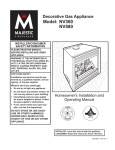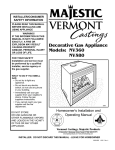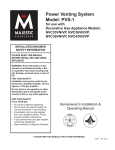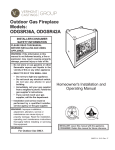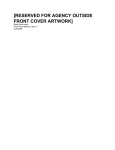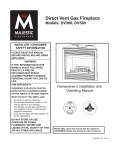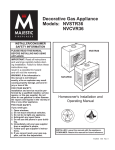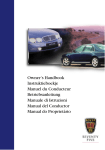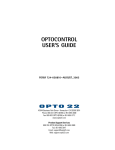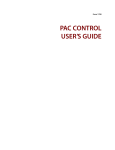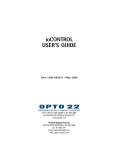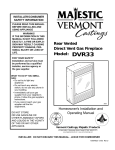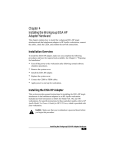Download Vermont Castings NVC43 Operating instructions
Transcript
Decorative Gas Fireplace Models: NVC36, NVC39, NVC43 INSTALLER/CONSUMER SAFETY INFORMATION PLEASE READ THIS MANUAL BEFORE INSTALLING AND USING APPLIANCE IMPORTANT: Read all instructions and warnings carefully before starting installation. Failure to follow these instructions may result in a possible fire hazard and will void the warranty. WARNING: If the information in this manual is not followed exactly, a fire or explosion may result causing property damage, personal injury or loss of life. FOR YOUR SAFETY Installation and service must be performed by a qualified installer, service agency, or the gas supplier. Do not store or use gasoline or other flammable vapors and liquids in the vicinity of this or any other appliance. Installation and Homeowners Operating Instructions FOR YOUR SAFETY If you smell gas: • • • • Do not touch electrical switches. Do not try to light any appliance. Do not use the phone in your building. Immediately call your gas supplier from a neighbor's phone. • Follow your gas supplier's instructions. • If you cannot reach your gas supplier, call the fire department. DE S I GN GF461 NVC cover 3/3/97 C E RT I F I E D CE RTIFI E D INSTALLER: Leave this manual with the appliance. CONSUMER: Retain this manual for future reference. 20000194 11/07 Rev. 7 NVC Series B-Vent Table of Contents Thank you and Congratulations on your purchase of a CFM Corporation fireplace. PLEASE READ THE INSTALLATION & OPERATING INSTRUCTIONS BEFORE USING THE APPLIANCE IMPORTANT: Read all instructions and warnings carefully before starting installation. Failure to follow these instructions may result in a possible fire hazard and will void the warranty. Installation Instructions General Information, Warnings, Cautions .......................................................................... 3 Requirements for the Commonwealth of Massachusetts .................................................... 4 Fireplace Dimensions .......................................................................................................... 5 Clearance to Combustibles ................................................................................................. 6 Mantels ............................................................................................................................... 6 Hearth ............................................................................................................................... 6 Framing and Finishing ......................................................................................................... 7 Final Finishing ..................................................................................................................... 7 Gas Specifications............................................................................................................... 7 Gas Inlet & Manifold Pressures ........................................................................................... 7 High Elevations ................................................................................................................... 7 Gas Line Installation ............................................................................................................ 8 Remote Switch Installation .................................................................................................. 8 Alternate Switch Location .................................................................................................... 8 EB-1 Electrical Box.............................................................................................................. 9 Install Venting System, Flashing and Termination ............................................................... 9 Operating Instructions Glass Information .............................................................................................................. 11 General Maintenance ........................................................................................................ 11 Louvre Removal ................................................................................................................ 11 Window Frame Assembly Removal................................................................................... 11 Glass Cleaning .................................................................................................................. 11 Log Installation .................................................................................................................. 12 Lava Rock, Ember Material Placement ............................................................................. 12 Flame Adjustment.............................................................................................................. 12 Flame Characteristics........................................................................................................ 12 Inspecting the Venting System .......................................................................................... 13 Test Chimney Draw ........................................................................................................... 13 First Firing ......................................................................................................................... 13 Lighting and Operating Instructions................................................................................... 14 Vent Safety Switch ............................................................................................................ 15 Electrical Connection......................................................................................................... 15 Troubleshooting ................................................................................................................. 16 Maintenance Cleaning the Standing Pilot Control System ..................................................................... 19 Replacement Parts Part Pictorial ...................................................................................................................... 20 Parts List ........................................................................................................................... 21 Optional Accessories Fan Kits 22 Wiring Instructions ............................................................................................................. 23 Remote Controls ............................................................................................................... 24 Ceramic Refractory Panels ............................................................................................... 24 Arched Door Kit ................................................................................................................. 24 Decorative Bay Windows .................................................................................................. 25 EB-1 Receptacle Box ........................................................................................................ 25 Decorative Frame Trims .................................................................................................... 25 Warranty ........................................................................................................................................ 27 Energuide ...................................................................................................................................... 28 2 20000194 NVC Series B-Vent Installation & Operating Instructions This gas appliance must be installed by a qualified installer, preferably NFI or WETT (Canada) certified, in accordance with local building codes and with current CSA-B149.1 Natural Gas and Propane Installation Code. If the unit is being installed in a mobile home, the installation should comply with the current CAN/CSA Z 240.4 code. For U.S.A Installations follow local codes and/or the current National Fuel Gas Code ANSI Z223.1/ NFPA 54. FOR SAFE INSTALLATION AND OPERATION PLEASE NOTE THE FOLLOWING: 1. This appliance gives off high temperatures and should be located out of high traffic areas and away from furniture and draperies. 2. Children and adults should be alerted to the hazards of the high surface temperatures of this appliance and should stay away to avoid burns or ignition of clothing. 3. CAUTION: Due to high glass surface temperature, children should be carefully supervised when in the same room as fireplace. � ������� �������������� ������������ ������������������ ������������� �������������������� ��������������� 4. Under no circumstances should this appliance be modified. Parts having to be removed for servicing should be replaced prior to operating this appliance again. 5. Installation and any repairs to this appliance should be carried out by a qualified service person. A professional service person should be contacted to inspect this appliance annually. Make it a practice to have all of your gas appliances checked annually. More frequent cleaning may be required due to excess lint and dust from carpeting, bedding material, etc. 6. Control compartments, burners and air passages in this appliance should be kept clean and free of dust and lint. Make sure that the gas valve and pilot light are turned off before you attempt to clean this unit. 7. The venting system (chimney) of this appliance should be checked at least once a year and if needed your venting system should be cleaned. 8. Keep the area around your appliance clear of combustible materials, gasoline and other flammable vapor and liquids. This appliance should not be used as a drying rack for clothing, nor should Christmas stockings or decorations be hung in the area of it. 9. Under no circumstances should any solid fuels (wood, coal, paper or cardboard etc.) be used in this appliance. 10.The flow of combustion and ventilation air must not be obstructed in any way. 11.Whether the appliance is installed directly on carpeting, vinyl tile or any combustible material other than wood, this appli- 20000194 ance must be installed on a metal or wood panel extending the full width and depth of the appliance. 12.This appliance requires adequate ventilation and combustion air to operate properly. 13.This fireplace must not be connected to a chimney flue serving a separate solid fuel burning fireplace. 14.When the fireplace is not in use it is recommended that the gas valve be left in the OFF position. The appliance and its individual shutoff valve must be disconnected from the gas supply piping system during any pressure testing of that system at test pressures in excess of 1/2 psig (3.45 kPa). NVC36 / NVC39 / NVC43 CERTIFIED To ANSI Z21.50b-2005 / CSA 2.22b-2005 Vented Decorative Gas Fireplace WARNING: Check with your electronics manufacturer before installing a television or other electronic device above this fireplace. This appliance may be installed in an aftermarket permanently located, manufactured home or mobile home, where not prohibited by local codes. This appliance is only for use with the type of gas indicated on the rating plate. This appliance is not convertible for use with other gases, unless a certified kit is used. IMPORTANT: PLEASE READ THE FOLLOWING CAREFULLY Remove any plastic from trim parts before turning the fireplace ON. It is normal for fireplaces fabricated of steel to give off some expansion and/or contraction noises during the start up or cool down cycle. Similar noises are found with your furnace heat exchanger or car engine. It is not unusual for your gas fireplace to give off some odor the first time it is burned. This is due to the curing of the paint and any undetected oil used in the manufacturing process. Please ensure that your room is well ventilated open all windows. It is recommended that your burn your fireplace for at least ten (10) continuous hours the first time you use it. If the optional fan kit has been installed, place the fan switch in the “OFF” position during this time. Proposition 65 Warning: Fuels used in gas, woodburning or oil fired appliances, and the products of combustion of such fuels, contain chemicals known to the State of California to cause cancer, birth defects and other reproductive harm. California Health & Safety Code Sec. 25249.6 3 NVC Series B-Vent Installation & Operating Instructions Requirements for the Commonwealth of Massachusetts All gas fitting and installation of this heater shall only be done by a licensed gas fitter or licensed plumber. For all side wall horizontally vented gas fueled equipment installed in every dwelling, building or structure used in whole or in part for residential purposes, including those owned or operated by the Commonwealth and where the side wall exhaust vent termination is less than seven (7) feet above finished grade in the area of the venting, including but not limited to decks and porches, the following requirements shall be satisfied: Installation of Carbon Monoxide Detectors At the time of installation of the side wall horizontal vented gas fueled equipment, the installing plumber or gas fitter shall observe that a hard wired carbon monoxide detector with an alarm is installed on each additional level of the dwelling, building or structure served by the side wall horizontally vented gas fueled equipment. It shall be the responsibility of the property owner to secure the services of qualified licensed professionals for the installation of hard wired carbon monoxide detectors. In the event that the side wall horizontally vented gas fueled equipment is installed in a crawl space or an attic, the hard wired carbon monoxide detector with alarm and battery back-up may be installed on the next adjacent floor level. In the event that the requirements of this subdivision can not be met at the time of completion of installation, the owner shall have a period of thirty (30) days to comply with the above requirements; provided, however, that during said thirty (30) day period, a battery operated carbon monoxide detector with an alarm shall be installed. Approved Carbon Monoxide Detectors Each carbon monoxide detector as required in accordance with the above provisions shall comply with NFPA 720 and ANSI/UL 2034 listed and IAS certified. Signage A metal or plastic identification plate shall be permanently mounted to the exterior of the building at a minimum height of eight (8) feet above grade directly in line with the exhaust vent terminal for the horizontally vented gas fueled heating appliance or equipment. The sign shall read, in print size no less than one-half (1/2) inch in size, “GAS VENT DIRECTLY BELOW, KEEP CLEAR OF ALL OBSTRUCTIONS”. 4 Inspection The state or local gas inspector of the side wall horizontally vented gas fueled equipment shall not approve the installation unless, upon inspection, the inspector observes carbon monoxide detectors and signage installed in accordance with the provisions of 248 CMR 5.08(2)(a)1 through 4. Exemptions The following equipment is exempt from 248 CMR 5.08(2)(a)1 through 4: • • The equipment listed in Chapter 10 entitled “Equipment Not Required To Be Vented” in the most current edition of NFPA 54 as adopted by the Board; and Product Approved side wall horizontally vented gas fueled equipment installed in a room or structure separate from the dwelling, building or structure used in whole or in part for residential purposes. MANUFACTURER REQUIREMENTS Gas Equipment Venting System Provided When the manufacturer of Product Approved side wall horizontally vented gas equipment provides a venting system design or venting system components with the equipment, the instructions provided by the manufacturer for installation of the equipment and the venting system shall include: • • Detailed instructions for the installation of the venting system design or the venting system components; and A complete parts list for the venting system design or venting system. Gas Equipment Venting System NOT Provided When the manufacturer of a Product Approved side wall horizontally vented gas fueled equipment does not provide the parts for venting the flue gases, but identifies “special venting systems”, the following requirements shall be satisfied by the manufacturer: • • The referenced “special venting system” instructions shall be included with the appliance or equipment installation instructions; and The “special venting systems” shall be Product Approved by the Board, and the instructions for that system shall include a parts list and detailed installation instructions. A copy of all installation instructions for all Product Approved side wall horizontally vented gas fueled equipment, all venting instructions, all parts lists for venting instructions, and/or all venting design instructions shall remain with the appliance or equipment at the completion of the installation. 20000194 NVC Series B-Vent Fireplace Dimensions N INSET A K 10" 5���" 7���" 3���" CL 6" Flue P L A 10" = 254mm 7���" = 187mm 5���" = 149mm 3���" = 92mm Finished Wall Thickness Rough Opening Width N M Rough Opening Height Gas Line Access 2" Dia. Gas Line Access - 2" Dia. Electrical Cable Knock-out 1" Dia. U V Electrical Cable Knock-out - 1" Dia. S B E Electrical Box Knock-out - 2" Dia. Outside Air Access (See inset A) T D A C Rough Opening Depth F G H Q R J Do not install header until unit is in place. Fig. 1 Fireplace specifications and framing dimensions. Appliance Dimensions Ref. 20000194 NVC36 A B C 36¹⁄₂" 34³⁄₄" 14¹⁄₂" D E F G H J K L M N P Q R S T U V 36" 21" 1" 5¹⁄₂" 7³⁄₄" 2" 20" 6" 47⁵⁄₈" 33⁵⁄₈" 24¹⁄₂" 10³⁄₄" 4" 32³⁄₄" 33" 34¹⁄₄" 36¹⁄₂" NVC39 Framing Dimensions (927������� mm) 39¹⁄₂" (1003 mm) (883�������� mm) 35" (889 mm) (362 FP378 mm) 16¹⁄₂" (419 mm) Appliance Dimensions (914 mm) 39" (991 mm) (533 mm) 21" (533 mm) (25 mm) 1" (25 mm) (140 mm) 6⁵⁄₁₆" (160 mm) (197 mm) 8²¹⁄₃₂" (220 mm) (51 mm) 2" (51 mm) (508 mm) 24" (610 mm) (152 mm) 6¹⁄₂" (165 mm) (1210 mm) 56" (1422 mm) (854 mm) 40" (1016 mm) (622 mm) 28⁹⁄₁₆" (726 mm) (273 mm) 12¹³⁄₃₂" (315 mm) (102 mm) 4" (102 mm) (832 mm) 32³⁄₄" (832 mm) (838 mm) 36" (914 mm) (870 mm) 34¹⁄₄" (870 mm) (927 mm) 37¹⁄₄" (946 mm) NVC43 43¹⁄₂" 37¹⁄₂" 16¹⁄₂" (1105 mm) (953 mm) (419 mm) 43" 23¹⁄₂" 1" 5¹⁄₂" 8" 2" 31" 5³⁄₄" 62⁵⁄₈" 44¹⁄₄" 32" 12" 4" 35¹⁄₂" 40" 37" 39¹⁄₄" (1092 mm) (597 mm) (25 mm) (140 mm) (203 mm) (51 mm) (787 mm) (146 mm) (1591 mm) (1124 mm) (813 mm) (305 mm) (102 mm) (902 mm) (1016 mm) (940 mm) (997 mm) 5 NVC Series B-Vent Clearance to Combustibles Appliances Top .......................................................... 0” (0 mm) Bottom ..................................................... 0” (0 mm) Side ......................................................... 0” (0 mm) Back ........................................................ 0” (0 mm) Perpendicular Sidewall ........................... 0” (0 mm) Top of unit to ceiling .......................... 36” (914 mm) Front of unit to combustibles ............. 36” (914 mm) Venting B-Vent ................................................... 1” (25 mm) Mantels The height that a combustible mantel is fitted above the fireplace is dependent on the depth of the mantel. This also applies to the distance between the mantel leg (if fitted) and the fireplace. J Black Surround Face CFM164 I H G Mantel Leg CFM164aSide of Combustion Chamber Mantel Leg Chart 06/22/01 sta M N O F K L For the correct mounting height and widths refer to Figures 2a and 2b and the Mantel Chart below. The distances and reference points are not affected by the fitting of a bay window front trim kit. Noncombustible mantels and legs may be installed at any height and width around the appliance. When using a paint or lacquer to finish the mantel, such paint or lacquer must be heat resistant to prevent discoloration. V Side View CFM170 W Ref. X Y F G H I J Z A B C D E Mantel Ref. Leg Depth 10" (254CFM170 mm) K DV Builder Front 8" (203 mm) L View 6" (152 mm) M 4" (101 mm) N 2" ( 51 mm) O Mantel Leg From Side of Comb. Opening 12" (305 mm) 10" (254 mm) 8" (203 mm) 6" (152 mm) 4" (101 mm) Fig. 2b Combustible mantel leg minimum installation. Fireplace Top Louvre Assembly Hearth Top of Combustion Chamber Bottom of Door Trim Ref. V W X Y Z Mantel Ref. CFM146 Shelf Depth DV Mantel Chart 7/5/01 sta 10" (254 mm) A 8" (203 mm) B 6" (152 mm) C 4" (101 mm) D 2" ( 51 mm) E CFM146 Mantel From Top of Comb. Chamber 19¹⁄₂" (495 mm) 17¹⁄₂" (444 mm) 15¹⁄₂" (394 mm) 13¹⁄₂" (343 mm) 11¹⁄₂" (292 mm) A hearth is not mandatory but is recommended for aesthetic purposes. We recommend a noncombustible hearth. Cold climate installation recommendation: When installing this unit against a noninsulated exterior wall or chase, it is mandatory that the outer walls be insulated to conform to applicable insulation codes. Fig. 2a Mantel clearances. 6 20000194 NVC Series B-Vent Framing and Finishing Gas Specifications Check fireplace to make sure it is levelled and properly positioned. 1. Choose the unit location. 2. Place the unit into position and secure it to the floor with 1¹⁄₂” (38mm) screws, or nails. The holes to secure the unit to floor are located just behind the access door grille on the left and right side of the unit. 3. Frame in the fireplace with a header across the top. It is important to allow for the finished wall face when setting the depth of the frame. 4. Attach the fireplace to the frame using the adjustable frame drywall strips (located behind the access door for shipping). Preset the depth to suit the facing material of the wall. The strips are adjustable to 1/2” (13 mm), 5/8” (16 mm), or 3/4” (19 mm). (Fig. 4) 5. Screw through the slotted holes in the drywall strip and into pre-drilled holes in fireplace side. Measure from face of fireplace to the face of the drywall strip to confirm the final depth. A B Adjustable Drywall Strip (Nailing Flange) Model NVC36RN NVC36RP NVC36VN NVC36NP NVC36EN NVC36EP NVC39RN NVC39RP NVC39VN NVC39VP NVC39EN NVC39EP NVC43RN NVC43RP NVC43VN NVC43VP NVC43EN NVC43EP Fuel Natural Propane Natural Propane Natural Propane Natural Propane Natural Propane Natural Propane Natural Propane Natural Propane Natural Propane Gas Control Millivolt Hi/Lo Millivolt Hi/Lo 24V Hi/Lo* 24V Hi/Lo* Electronic Ignition Electronic Ignition Millivolt Hi/Lo Millivolt Hi/Lo 24V Hi/Lo* 24V Hi/Lo* Electronic Ignition Electronic Ignition Millivolt Hi/Lo Millivolt Hi/Lo 24V Hi/Lo* 24V Hi/Lo* Electronic Ignition Electronic Ignition Drywall Depths 1/2” / 13 mm 5/8” / 16 mm 3/4” / 19 mm Min. Input 17,500 18,750 17,500 18,750 17,500 18,750 21,000 22,500 21,000 22,500 21,000 22,500 23,100 24,750 23,100 24,750 23,100 24,750 NOTE: VN and VP models are for use the PVS-1 Power Vent System. Gas Inlet & Manifold Pressures C Screw Position A B C Max. Input 25,000 25,000 25,000 25,000 25,000 25,000 30,000 30,000 30,000 30,000 30,000 30,000 33,000 33,000 33,000 33,000 33,000 33,000 Natural LP Minimum Inlet Pressure 5.5" w.c. 11.0" w.c. Maximum Inlet Pressure 14.0" w.c. 14." w.c. Manifold Pressure 3.5" w.c. 10.0" w.c. High Elevations Input ratings are shown in BTU per hour and are certified without deration for elevations up to 4,500 feet (1,370m) above sea level. Adjustable 1/2”, 5/8” & 3/4” Spacing FP1023 Fig. 4 Adjustable drywall strip (nailing flanges). Final Finishing For elevations above 4,500 feet (1,370m) in USA, installations must be in accordance with the current ANSI Z223.1/NFPA 54 and/or local codes having jurisdiction. In Canada, please consult provincial and/or local authorities having jurisdiction for installations at elevations above 4,500 feet (1,370m). Noncombustible materialsFP1023 such as brick or tile may be nailing extended over the edges side of the face flange of the appliance. 1/27/00 djt DO NOT cover the window frame assembly, any vent, louvre top assembly or louvre bottom assembly. If a Trim Kit is going to be installed on the fireplace, the brick or tile will have to be installed flush with the edges of the appliance. 20000194 7 NVC Series B-Vent Gas Line Installation 1/2" Gas Supply When purging gas line the fornt glass must be removed. Purging gas lines must comply with ANSI Z223.1/NFPA 54 in USA and CSA B149.1 in Canada. The gas pipeline can be brought in through the right or left side of the appliance, as well as the bottom. Knockouts are provided at convenient locations to allow for the gas pipe installation and testing of any gas connection. It is most convenient to bring the gas line in from the right side, as this allows fan installation or removal without disconnecting the gas line. The gas line connection can be made with properly tinned 3/8" copper tubing, 1/2" rigid pipe or an approved flex connector, then reduced to 3/8" (R Models) or 1/2" (E Models) to the appliance. Because some municipalities have some additional local codes, it is always best to consult your local authority and the CSA-B149.1 installation code. For US installations consult the current National Fuel Gas Code, ANSI Z223.1/NFPA 54 . Always check for gas leaks with a mild soap and water solution applied with a brush no larger than 1" (25mm). Never aply soap and water solution with a spray bottle. Do not use an open flame for leak testing. The fireplace valve must not be subjected to any test pressures exceeding 1/2 psi. Isolate or disconnect this or any other gas appliance control from the gas line when pressure testing. The gas control is equipped with a captured screw type pressure test point, therefore it is not necessary to provide a 1/8" test point up stream of the control. 1/2" x 3/8" Shut-off Valve 3/8" Nipple 3/8" Union 3/8" Nipple "R" Model Supply Line 1/2" Gas Supply 1/2" x 1/2" Shut-off Valve 1/2" Nipple 1/2" Union 1/2" Nipple "E" Model Supply Line FP413 Fig. 5 Typical gas supply installation. Fan Speed Control Temperature GF413 Sensor nvt GAS SUPPLY INSTALL 12/16/96 Black White Ground FP394 Fig. 6 Wiring diagram. Alternate FP394 WIRING DIAGRAM Switch Location 11/20/96 Remote switch can be installed on either side of the access door. Simply mount the switch to the switch bracket provided. Screw the bracket on either side of the frame, lining up the screws with the pre-punched holes. (Fig. 7) When using copper or flex connector use only approved fittings. Always provide a union so that gas line can be easily disconnected for burner or fan servicing. Refer to gas specification for pressure details and ratings. NOTE: If flex connector is used, it must be kept inside of the appliance. (Fig. 5) Remote Switch Installation 1. Thread wire through the electrical knockout located on either side of unit. Do not cut wire or insulation on metal edges. Ensure that wire is protected. Run the other end to a conveniently located wall receptacle box. 2. Attach wire to switch and install switch into receptacle box. Attach cover plate to switch. 3. Connect wiring to gas valve. (Figs. 19 or 20, Page 14) 8 Pre-punched Holes FP381 Fig. 7 Installing remote switch bracket. FP381 NVC/UVC-Remote switch bracket 11/12/98 20000194 NVC Series B-Vent EB-1 Electrical Box Inside The fireplace, when installed, must be electrically connected and grounded in accordance with local codes or, in the absence of local codes, with the current CSA C22.1 Canadian Electrical Code Electrical Box Retaining Screw Front of For USA installations follow the local codes and the national electrical code ANSI/NFPA No. 70. It is strongly suggested that the wiring of the EB-1 Electrical Junction Box be carried out by a licensed electrician. Unit Outside Ensure that the power to the supply line has been disconnected before commencing this procedure. The EB-1 Electrical junction box has been supplied standard on the DVRT 36/39/43 models to allow for the easy installation of an optional fan kits. To connect the EB-1 box to the house electrical supply follow the steps below. 1. Unscrew the retaining screw from the EB-1 base plate (Fig. 8) and remove the EB-1 assembly from the fireplace. 2. Remove the front cover of the EB-1 box. 3 Remove the plug socket assembly from the EB-1 box. 4. Feed the supply line in from the outside through the cable clamp. (Fig. 8) 5. Connect black wire of the power supply line to the brass screw (polarized) of the socket assembly. 6. Connect the white wire of the power line to the chrome screw of the socket assembly. 7. Connect the ground wire of the supply line to the green screw of the socket assembly. 8. Refit the socket assembly back into the electrical box and replace the cover plate. Secure the cable with the clamp on the outside of the unit to prevent strain on the connections. 9. The EB-1 electrical junction box is now ready to supply power to the FK12 or FK24 fan kits if fitted. 20000194 Fron t of U nit FP580 Fig. 8 EB-1 receptacle. Install the Venting System, FP580 Flashing and Termination INSTA VENT FREE EB1 JUNCTION BOX Refer to venting installation instructions provided by the 11/18/97 B-Vent manufacturer. Refer to Figure 1, Page 3 to locate chimney center line dimension from a combustible back wall. • Minimum vertical chimney height — 12' (3.65 m) • Maximum vertical height — 40' (12 m) • Minimum height with two elbows — 12' (3.65 m) • Elbow requirements allow a maximum of two 90° elbows or four 45° elbows per installation. (Two 45° elbows = One 90° elbow.) See venting chart for proper elbow offset runs. For firestop positioning, refer to Figure 9. Only one (1) firestop required per frame. NOTE: A firestop is not required at the roof. 9 NVC Series B-Vent Horizontal Run (in feet) Nails (4) 3 4 Firestop Spacer 40 38 36 34 Joist 5 6 7 8 9 10 11 12 A B 32 Ceiling Installation Firestop position when area above ceiling is NOT an attic. 30 28 26 24 22 (Firestop/draftstop appearances may vary. Only 1 firestop required per frame.) FP384 Fig. 9 Firestop/draftstop positions. FP384 FIRESTOP 11/21/96 adapted from IGF53 Vertical Run (in feet) (Measured from floor of unit tocenter of horizontal vent pipe.) Venting Runs Attic Installation Firestop position when area above ceiling is an attic. 20 18 16 14 12 = Acceptable venting configuration = Unacceptable venting configuration A: Vertical installations up to 40 feet (12m) in height. Up to a 8 ft. horizontal vent run can be installed within the vent system using a maximum of two 90-degree elbows or four 45-degree elbows. B: Vertical installations up to 40 feet (12m) in height. Up to a 12 ft. horizontal vent run can be installed within the vent system using a FP567a maximum of two 45-degree elbows. Table 1 Venting configurations. FP567a NVBR/NVBC VENTING RUNS 11/12/97 10 20000194 NVC Series B-Vent Operating Instructions Glass Information Only glass approved by CFM Corporation should be used on this fireplace. • The use of any non-approved replacement glass will void all product warranties. • Care must be taken to avoid breakage of the glass. • Do not operate appliance with glass front • removed, cracked or broken. Replacement glass (complete with gasket) is available through your CFM Corporation dealer and should only be installed by a licensed qualified service person. � ������� �������������������� ��������������� Louvre Removal 2. Louvre Top Assembly Glass Panel FP383 Window Fig. 10 Louvre install and removal. GF383 NVC 11/20/96 Frame Assembly Removal REMOVE LOUVRE/GRILLE 1. Turn gas off. 2. Let the unit cool if it has been operating. 3. Remove louvre top assembly. (Refer to Louvre Removal section.) 4. Open louvre bottom assembly. 5. Release the two clamps at the bottom of the window frame by pulling down on the clamp handles. 6. Lift off the window frame assembly as shown. (Fig. 11) 7. To reinstall window frame assembly, follow the above procedure in reverse. 20000194 Pull Clamp Push Hook Clamp Handle Fig. 11 Window frame assembly removal. ������������������ ������������� 1. Window Frame Assembly Window Frame Assembly FP1191 �������������� ������������ To remove the louvre top assembly, lift louvre up and then out. (Fig. 12) The louvre bottom assembly is hinged at the bottom edge and swings down. Lower Clamps Glass Cleaning It is necessary to clean the glass periodically. During start-up, condensation, which is normal, forms on the inside of the glass and causes lint, dust and other airborne particles to cling to the glass surface. Also initial paint curing may deposit a slight film on the glass. It is therefore recommended the glass be cleaned two or three times with a non-ammonia household cleaner and warm water (gas fireplace glass cleaner is recommended). After initial use glass should be cleaned two or three times during heating season. Clean glass after first two weeks of operation. Do not clean glass when hot. Do not use abrasive cleaners. Do not strike or slam the glass. Log Installation 1. Remove window frame assembly. (Refer to Page xx) 2. Remove logs from the packaging. As with all plastic, these bags are not toys and should always be kept away from children and infants. 3. Place rear log on back bracket. Ensure that log is firmly positioned and there is no side-to-side movement. 4. Place the front log on top of the burner, use bottom holes to locate the logs on top of the studs. 5. Place the front right log on top of the burner, Use bottom holes to locate the logs on top of the studs. 11 NVC Series B-Vent NVC39 BC5 BC6 BC7 BC8 BC9 NVC43 BD6 BD7 BD8 BD9 BD10 BB9 Log Top Left BE5 Log Rear BB10 Log Top Right BB6 Log Front Left BB7 Log Front Rigth NVC36 BC8 Log Top Left BC9 Log Top Right BC7 Log Rear FP NVC36 LOG SET 8-11-98 BC5 Log Front Left BC6 Log Front Right BD9 Log Top Left NVC39 LOG SET BD10 Log Top Right 8-12-98 Ember Material Placement Separate the ember material into small pieces, roughly 1/2" in diameter, and place onto the burner in front of the front logs. Do NOT pack down, leave in fluffy, loose condition for more realistic ember effect. Flame Adjustment For fireplaces equipped with HI/LO valves, flame adjustment is accomplished by rotating the HI/LO adjustment knob located near the center fo the gas control. (Fig. 13 or 14) Turn counterclockwise to decrease flame height HI Turn clockwise to increase flame height HV102 Fig. 13 Flame adjustment knob for Honeywell valve. IH Turn clockwise to decrease flame height HV102 LO Honeywell hi/lo knob 4/5/99 djt Fig. 14 Flame adjustment knob for SIT valve. HV116 Flame Characteristics BD6 Log Front Left BD7 Log Front Right 3/8"-1/2" Ignition A HI FP NVC43 LOG SET 8-12-98 It is important to periodically perform a visual check of the pilot and burner flames. Compare them to the , HV116 pictorials illustrated below. 15 or 16) If the flame SIT (Figs. 820 knob patterns appear abnormal contact 1/14/02 djt a qualified service provider for service and adjustment. ELECTRONIC Nova Sit 822 Valve Electronic IGNITION E NVC43 Fig. 12 Log locations. Under no circumstances should this lava rock be placed on any part of the burner assembly. Turn counterclockwise to increase flame height NVC39 BD8 Log Rear The lava rock provided with this fireplace must be placed on the firebox base on either side of the burner assembly. Do not place lava rock in combustion pan. LO Front Left Log Front Right Log Rear Log Top Left Log Top Right Log NVC36 BB6 BB7 BE5 BB9 BB10 Lava Rock LO 6. Place the top logs onto the locator notches. Ensure that the logs are secure. (Fig. 12) 7. Place ember material. See "Ember Material Placement" section. OT PIL FP392/585 Fig. 15 Proper pilot flame height. 12 FP392 NVC-PILOTS 11/21/96 FP584 NVB 20000194 NVC Series B-Vent Test Chimney Draw NVC36 A "Chimney Draw" test must be made before the installation is complete. 1. Close all doors and windows in the home and start exhaust fans in the kitchen and bathroom. 2. Light unit and operate for 5 minutes. 3. Hold an ignited match, cigarette, or smoke match in front of the unit. Refer to Figure 17 for location of the draft hood opening. 4. Check to make sure smoke from the match, cigarette or smoke match is drawn into the fireplace. If it is not, turn the unit off and check for causes creating the lack of adequate draft. Do not operate the unit until lack of adequate draft has been determined and rectified. NVC39 Test for Draft at This Location NVC43 FP393 Fig. 16 Approximate flame heights for each model. FP393 8/25/98 Inspecting Venting NVCthe FLAME HEIGHTSSystem This appliance venting system is designed and constructed to develop a positive flow adequate to remove flue gases to the outside atmosphere. Any foreign objects in the venting system, except those designed specifically for the venting system, may cause spillage of flue gases. To inspect the venting system, make sure the main gas valve is off. Remove the window frame assembly (Refer to Page 10). Using a flashlight, check the area above the baffle in the combustion dome. Clean if necessary. FP1197 Fig. 17 Draft test location. First Firing FP1197 test location Remove window framedraft assembly before lighting. 2/27/02 djt Upon completing the gas line connection, a small amount of air will be trapped in the line. When first lighting the unit with pilot light, it will take a few minutes to purge the trapped air. Once purging is complete, the pilot and burner will light and operate as indicated in the instruction manual. Subsequent lightings of the appliance will not require purging. When lit for the first time, the appliance will emit a slight odor for awhile. This is due to paint and lubricants used in the manufacturing process. After each lighting, vapor may condense and fog the glass; this moisture disappears within a few minutes of burning. 20000194 13 NVC Series B-Vent Lighting and Operating Instructions FOR YOUR SAFETY READ BEFORE LIGHTING WARNING:If you do not follow these instructions exactly, a fire or explosion may result causing property damage, personal injury or loss of life. A. This heater has a pilot which must be lit manually. When lighting the pilot follow these instructions exactly. B. BEFORE LIGHTING smell all around the heater area for gas. Be sure to smell next to the floor because some gas is heavier than air and will settle on the floor. WHAT TO DO IF YOU SMELL GAS • Do not try to light any fireplace • Do not touch any electric switch • Do not use any phone in your building • Immediately call your gas supplier from a neighbor's phone. Follow the gas supplier's instructions. • If you cannot reach your gas supplier, call the Fire Department C. Use only your hand to push in or turn the gas control knob. Never use tools. If the knob will not push in or turn by hand, do not try to repair it, call a qualified service technician. Applying force or any attempted repair may result in a fire or explosion. D. Do not use this fireplace if any part has been under water. Immediately call a qualified service technician to inspect the heater and to replace any part of the control system and any gas control which has been under water. Lighting Instructions 1. STOP! Read the safety information above. 2. Turn off all electrical power to the fireplace. 3. For MN/MP/TN/TP appliances ONLY, go on to Step 4. For RN/RP appliances turn the On/Off switch to “OFF” position or set thermostat to lowest level. 4. Open control access panel. 5. Push in gas control knob slightly and turn clockwise to "OFF". ON OFF 3/8" - 1/2" OFF OFF 3 4 5 Euro SIT OT L PI ON 1 2 P OFF ilot PILOT 10. Push the control knob all the way in and hold. Immediately light the pilot by repeatedly depressing the piezo spark ignitor until a flame appears. Continue to hold the control knob in for about one (1) minute after the pilot is lit. Release knob and it will pop back up. Pilot should remain lit. If it goes out, repeat steps 5 through 8. SIT NOVA Honeywell 6. Wait five (5) minutes to clear out any gas. Then smell for gas, including near the floor. If you smell gas, STOP! FP1067 Follow "B" in the safety information above. If you doinstruction not smell gas, go to the lighting knobs next step. 3/9/01 djt 7. Remove glass door before lighting pilot. (See Glass Frame Removal section). 8. Visibly locate pilot by the main burner. 9. Turn knob on gas control counterclockwise to "PILOT". • If knob does not pop up when released, stop and immediately call your service technician or gas supplier. FP1068 • If after several tries,Lighting the pilot will not stay lit, instructions turn the gas control knobPilots to "OFF" and call your service technician or gas supplier. 11. Replace glass door. 12. Turn gas control knob to “ON” position. 13. For RN/RP appliances turn the On/Off switch to “ON” position or set thermostat to desired setting. 14. Turn on all electrical power to the fireplace. To Turn Off Gas To Heater 1. Turn the On/Off switch to Off position or set the thermostat to lowest setting. 2. Turn off all electric power to the fireplace if service is to be performed. 14 3. Open control access panel. 4. Push in gas control knob slightly and turn clockwise to "OFF". Do not force. 5. Close control access panel. 20000194 NVC Series B-Vent Vent Safety Switch Electrical Connection This fireplace incorporates the use of a Vent Safety Shut-off Switch. The sensor and wiring are factory installed and should not be removed or altered during installation. The sensor is wired in series between the wall mounted ON/OFF switch and the Electronic Ignition Module (Fig. 19) or the thermopile and the gas valve (Fig. 20) In the event of total flue blockage the system will detect the increased heat buildup and will automatically shut down the main burner assembly. The sensor is located above the firebox behind the top louvre assembly. It is accessible by removing the top louvre assembly. WHITE PILOT CAUTION: The firebox, Vent Safety Switch sensor and surrounding panels become very hot during normal operation. Allow time for the components to cool before carrying out any service or inspection. SPARK SENSE WHITE BLACK BLACK WHITE BLACK WHITE Block Flue Switch (NVC Only) LO LO T PILO NOVA SIT 822 VALVE BLACK 24 VAC HOT 120 VAC RTN 1 5 WHITE 3 4 BLACK 120 VAC HOT BLACK WHITE 24 VAC RTN 40VA TRANSFORMER GREEN BLACK WHITE ON-OFF SWITCH FP670 Fig. 19 Vent Safety Switch wiring, EN/EP units. FP670 NOVA SIT 822 VALVE WIRING DGRM. (w/ Honeywell S8600 B Ignition Module) Thermopile 4/30/98 OnN/OFF Switch Vent Safety Switch Wire Terminal BLACK 24V HI Sensor 24V GND A burner assembly shuts down again after a period of operation, DO NOT ATTEMPT TO RESET THE SENSOR AGAIN. Turn off the fireplace and contact your service technician. GND (BURNER) HI • Light the fireplace and check for downdrafts. • Operate the fireplace in the normal manner. If the PV WHITE • Observe that the pilot flame is still ON. If the pilot flame has gone out the reason for the fireplace shut down is not the vent safety switch. • Turn the pilot flame OFF and close all controls. Allow the fireplace to cool. • Check the flue and venting components for blockage or restrictions. • Remove the front louvre assembly. • Locate the sensor. • Reset the sensor by pressing the reset pin between the two wire terminals. (Fig. 18) CAUTION: The components may still be hot. MVPV E If the sensor is activated and shuts off the burner assembly, the following procedure should be followed: HONEYWELL S8600 B IGNITION MODULE MV TH Wire Terminal TP TH TP Gas Valve FP1161 Reset Pin FP1160 Fig. 20 RN/RP units using a remote ON/OFF switch. Fig. 18 Vent Safety Switch. 20000194 FP1160 Vent safety switch 11/2/01 djt FP1161 Vent Safety Switch Wiring 11/2/01 djt 15 NVC Series B-Vent Troubleshooting Honeywell Electronic Ignition START Turn gas supply off Turn ON/OFF Switch to call for heat. NO CHECK : Power to module (24V nominal) YES Spark across Ignitor Sensor gap NO Line Voltage (120VAC) Low Voltage Transformer (19.5 minimum VAC) ON/OFF Switch Wiring connections Thermodisk Unplug Ignition Lead and check spark at module (24VAC nominal) NO Replace Module Spark OK? YES YES Check ignition cable, ground wiring, Ceramic Insulator and gap. Correct as necessary Check boot of ignition cable for signs of melting or buckling. Take protective actions to shield cable and boot from excessive temperatures. Turn gas on NO Pilot burner lights? YES Spark stops when pilot is lit? NO NO YES System runs until ON/OFF switch is in "OFF" position YES NOTE: If S8600B goes into lockout, reset system. Check continuity of ignition cable and ground wire. Clean flame rod. Check electrical connections beween flame rod and module. Check for cracked ceramic flame rod insulator. Check that pilot flame covers flame rod and is steady blue. Adjust pilot flame. If problem persists, replace module. YES Main Burner lights? Check that all manual gas valves are open, supply tubing and pressures are good, and pilot burner orifice is not blocked. Check electrical connections between module and pilot operator on gas control. Check for 24VAC across PV-MV/PV terminals on module. If voltage is okay, replace gas control. If not, replace module. NO Check for 24VAC across MV-MV/PV terminals. If no voltage, replace module. Check electrical connections between module and gas control. If okay, replace gas control or gas control operator. NOTE: If S8600B goes into lockout, reset system. Check for continuity of igniton cable and ground wire. NOTE: If ground is poor or erratic, shutdowns may occur occasionally even though operation is normal at time of checkout. Check that the pilot flame covers flame rod and is steady and blue. If checks are okay, replace module. Troubleshooting Ends 16 FP649 Honeywell S8600B T-shoot Guide 5/5/98 FP649 20000194 NVC Series B-Vent Troubleshooting Honeywell VS8421 Remove glass door before service work CHECK START Gas Supply On NO • Supply Line Hooked Up • Shutoff Valve Open YES • Lockout Has Engaged. Wait 60 Seconds And Try Again. • For Spark At Electrode While Pilot Lights With Piezo Ignitor NO • • Depressing Piezo 1/8" Gap To Pilot Hood Needed. All Wiring Connections Replace Piezo Ignitor YES • For Air In The Lines • Thermopile Needs A Min. Pilot Stays Lit NO • • • • YES 325mv. Adjust Pilot Flame Height. All Wiring Connections Replace Thermopile Thermocouple Needs A Min. Of 14mv Defective Valve. Turn To Pilot, Meter Should Read Greater Than 100mv. If Not, Replace. • Valve Is Turned On • Wall Switch Is Not Turned On. Pilot Lights Main Burner NO • • Watch For Grounded Wires! Thermopile Needs A Min. 325mv. Plugged Burner Orifice YES System Ok 20000194 17 NVC Series B-Vent Troubleshooting Nova SIT 820 Standing Pilot START Gas Supply On CHECK NO Supply Line Hooked Up Shutoff Valve Open YES Pilot Lights With Piezo Ignitor NO YES Pilot Stays Lit NO Lockout Has Engaged. Wait 60 Seconds and Try Again. Piezo Nut Tight for Good Ground. For Spark at Electrode While Depressing Piezo (Red Button) - 1/8" Gap to Pilot Hood Needed. All Wiring Connections Replace Piezo Ignitor Check thermodisk For Air in the Lines Thermopile Needs a Minimum 325Mv. Adjust Pilot Flame Height. All Wiring Connections. Replace Thermopile Thermocouple Needs a Minimum of 14Mv. YES Pilot Lights Main Burner YES NO Valve is Turned On Wall Switch is Not Turned On. Watch for Grounded Wires! Thermopile Needs a Minimum 325Mv. Plugged Burner Orifice. Defective Valve. Turn to Pilot, Meter Should Read Greater Than 100 Mv. If Not, Replace. System Ok. FP396 NVC-standing pilot troubleshooting 8/17/98 18 FP396 20000194 NVC Series B-Vent Maintenance Burner and Burner Compartment It is important to keep the burner and the burner compartment clean. At least once per year the logs and lava rock/ember material should be removed and the burner compartment vacuumed and wiped out. Remove and replace the logs as per the instructions in this manual. Always handle the logs with care as they are fragile and may also be hot if the fireplace has been in use. FK24 Fan Assembly Nova Sit 822 Valve E ELECTRONIC Electronic Ignition Nova SIT Pilot A The fan unit requires periodic cleaning. At least once per month in the operating season, open the lower louvre panels and wipe or vacuum the area around the fan to remove any build up of dust or lint. To obtain proper operation, it is imperative that the pilot and burner’s flame characteristics are steady, not lifting or floating. Typically, the top 3/8” or 1/2” of the thermopile should be engulfed in the pilot flame. (Fig. 21) To adjust pilot burner; (by qualified service technician) 1. Remove pilot adjustment cap. 2. Adjust pilot screw to provide properly sized flame. 3. Replace pilot adjustment cap. The primary air shutter is set at factory and should only be adjusted, if necessary, by a qualified service technician. IGNITION Brass Trim The burner and control system consists of • burner tube • gas orifice • pilot assembly • thermopile • millivolt gas valve Most of these components may require only an occasional checkup and cleaning and some may require adjustment. If repair is necessary, it should be performed by a qualified technician. CAUTION: Logs may be hot! LO OT PIL Cleaning the Standing Pilot Control System 3/8"-1/2" HI Clean the brass trim pieces using a soft cloth lightly dampened with lemon oil. Do not use water or household cleaners on any brass components. FP392/585 Fig. 21 Correct pilot flame appearance. FP392 NVC-PILOTS 11/21/96 FP584 NVB 12/4/97 1. Turn off pilot light at gas valve side. 2. Let fireplace cool if it has been running. 3. Remove window frame assembly. (Refer to Window Frame Assembly Removal section) 4. Remove logs. 5. Vacuum burner compartment especially around orifice primary air openings. 6. Visually inspect pilot. Brush or blow away any dust or lint accumulation. 7. Reinstall logs. 8. Ignite pilot - Refer to Lighting Instructions. 9. Reinstall window frame assembly. 20000194 19 NVC Series B-Vent NVC43 Logs 1 NVC39 1 NVC36 1e 1d 1e 1d 1e 1d 1c 1c 1c SIT Valve 1a 15-16a/b � ������ ��� � ��� TH ��� � ��� �� �� ������ �� � ������� ���� NOVA SIT 822 VALVE � TP ����� 20/21 � � � � �� �� THTP 6a/b 1b � 18 3 2 1b 1a 1b 1a ����� �� ���� � � � ������ ����� � � ��� � GND (BURNER) 24V 24V SENSE �� 13 8a/b 14 27 5 10 SPARK � PV �� ��� � ����� �� � � MVPV � ��� � MV � ��������� � � �� �� 7a/b 4a/b 17a/b ����� ������ ����� � 12 28 39a/b 22 25 19 29 26 9 11a 40 a/b 33 11b 9 34 37 PILOT ADJ I L ON O H PIL T OFF O 30 35 36 41 32 31 CFM Corporation reserves the right to make changes in design, materials, specifications, prices and discontinue colors and products at any time, without notice. NVC36/39/43 For Units: B32H00, B32I00, B33A00, B33B00, B32J00, B32K00, C32H00, C32I00, C32A00, C32B00, C32J00, C32K00, D32H00, D32I00, D33A00, D33B00, D32J00, D32K00 Ref. Description 1. Log Set Complete 1a. Log Front Left 1b. Log Front Right 1c. Log Rear 1d. Log Top Left 1e. Log Top Right 2. Lava Rock (pkg) 3. Ember (pkg) 20 FP772A Replacement Parts nvc 8/25/98 NVC36 10000022 BB6 BB7 BE5 BB9 BB10 55255 51915 NVC39 10000024 BC5 BC6 BC7 BC8 BC9 55255 51915 NVC43 10000025 BD6 BD7 BD8 BD9 BD10 55255 51915 20000194 NVC Series B-Vent NVC36/39/43 (continued) Ref. 4a. 4b. 5. 6a. 6b. 7a. 7b. 8a. 8b. 9. 10. 11a. Description Burner Housing w/tile-Nat Burner Housing w/tile-LP Ceramic tile (Single) Orifice Front Burner-Nat. Orifice Front Burner-LP Pilot Assy- SIT Top Convertible, LP Pilot Assy - SIT Top Convertible, Nat. Orifice Pilot - Nat. Orifice Pilot - LP Pilot Tubing w/Fittings Electrode Ignitor Cable Ignitor (RNRP/VN/VP) 24” 11b. 12. 13. 14. 15a. 15b. 16a. 16b. 17a. 17b. 18. 19. 20. 21. 22. 23. 24. 25. 26. 27. 28. 29. 30. 31. 32. 33. 34. 35. 36. 37. 38. 39a. 39b. Cable Ignitor (EN/EP) Ignitor Piezo Thermocouple (RN/RP/VN/VP) Thermopile (RN/RP) Valve SIT - RN Valve SIT - RP Valve SIT - VP Valve SIT - VN Valve SIT - EN Valve SIT - EP Manifold Tubing w/Fittings Transformer (VN/VP/EN/VP) Ignition Device Synetek (EN/EP) Ignition Device Honeywell (EN/EP) Sensing Electrode (EN/EP) Wire Harness (EN/EP) Synetek Ign. (not shown) Wire Harness (EN/EP) Honeywell Ign. (not shown) Fan w/Bracket (FK24) Electrical Cord - 6 ft. Fan Temperature Sensor Speed Control Speed Control Knob Glass w/Gasket Gasket Glass Frame Window Clamp Frame Window Louvre Assembly Top Louvre Assembly Bottom Hinge Switch ON/OFF Remote Switch Kit (not shown) Pilot Assy - Nat. Pilot Assy - LP 20000194 NVC36 10000027 10000028 57803 10002265 10002264 20002268 20002269 10001296 52465 53194 7522432 10000696 52464 53373 51827 52677 52678 57587 57588 57884 57883 57318 7522409 57899 20000005 57885 10000417 10000609 54103 51865 51704 51738 51882 10001781 57317 57937 54174 10000037 10000038 52356 51842 53875 10002387 10002388 NVC39 10000033 10000694 57803 See Rating Plate See Rating Plate 10002265 10002264 20002268 20002269 10001296 52465 53194 7522432 10000696 52464 53373 51827 52677 52678 57587 57588 57884 57883 57318 7522409 57899 20000005 57885 10000417 10000609 54103 51865 51704 51738 51882 10002821 57317 10000695 54174 10000039 10000040 52356 51842 53875 10002387 10002388 NVC43 10000029 10000030 57803 10002265 10002264 20002268 20002269 10001296 52465 53194 7522432 10000696 52464 53373 51827 52677 52678 57587 57588 57884 57883 57318 7522409 57899 20000005 57885 10000417 10000609 54103 51865 51704 51738 51882 57438 57317 57977 54174 10000041 10000042 52356 51842 53875 10002387 10002388 21 NVC Series B-Vent NVC36/39/43 (continued) Ref. 40a. 40b. 41. 22 Description Valve - Honeywell VS8421 - Nat. Valve - Honeywell VS8421 - LP Vent Safety Switch NVC36 10001782 10001759 10002013 NVC39 10001782 10001759 10002013 NVC43 10001782 10001759 10002013 20000194 NVC Series B-Vent Optional Accessories Fan Kits FK12 Fan Assembly 1. Open louvre assembly bottom. 2. Install FK12 fan in back of unit between hearth supports. The fireplace, when installed must be electrically connected and grounded in accordance with local codes or, in the absence of local codes, with the current CSA C22.1 Canadian Electrical Code or for US installations, follow local codes and the National Electrical Code, ANSI/NFPA No. 70. Hard (Direct) Wire Hook-Up 3. Secure fan on velcro strips. 4. Power to the fan can be supplied by plugging the supply lead into a conveniently located wall socket or by using a hard-wired EB-1 connector box. 5. Be sure fan motor does not touch nearby metal. FK24 Fan Assembly First connect the ground wire to the ground stud located on the base of either box. Black wire from supply should connect to the variable speed switch. Alternate speed switch wire connects to temperature sensor. Alternate lead from sensor connects to fan. Alternate fan lead connects back to the white supply wire. (Fig. 23) Fan specifications: 120 volt, 60 Hz, .75 Amps This fan does not need regular maintenance, however periodic cleaning is required. Check the area under the control door and in front of the fan and wipe or vacuum at least once a month during the operating season. Should this fan require servicing, the power supply must be disconnected. Any electrical rewiring of this fan must be completed by a qualified electrician. Turn off all power before hook-up. Electrical Box Heat Sensor Fan The FK-24 comes with the electrical cord attached. 1. Slide fan assembly from the left side into the fireplace opening, line up mounting holes with screw studs on back of fireplace and fasten with #10-24 hex nuts. A OFF OFF FF HI N O PIL T Method B - If the EB-1 receptacle box (Pt. #ZA1200) was correctly connected when the unit was installed, the fan lead can be directly plugged into the EB-1 plug socket. TO 4. The power supply may be connected in 2 ways: Method A - route the 6' (1.8m) lead fitted to the unit to a conveniently located wall socket. PILO (Option B) - The speed control can be installed in an electrical box at normal wall switch height for convenient access. O TH 2. Install thermal sensor on bottom of firebox using #10-24 hex nuts. 3. (Option A) - Place electronic fan speed control box on bottom of fireplace base, lining up mounting holes with screw studs. Fasten fan speed control box with #10-24 hex nuts. E TP LO Fan Speed Switch Gas Line Valve FP1026 Fig. 22 FK-24 fan placement. Temperature Sensor Speed Control FP1026 Fan FK24 fan placement 1/27/00 djt Black White Ground FP1025 Fig. 23 FK-24 fan wiring. FP394 WIRING DIAGRAM 11/20/96 5. Whether wiring directly to the fan junction box, (Option A) or into the EB-1 (Option B), first ensure cable is secured using box connector. 20000194 23 NVC Series B-Vent Remote Controls Optional remote control units are available to control different functions of the appliance. Model RC1 RC2 IMTFK Function(s) Controlled ON/OFF ON/OFF and Temperature Wall mounted thermostat control Ceramic Refractory Panels Ceramic refractory panels are available to line the firebox area. Unit NVC36 NVC39 NVC43 Kit Model NV36CR NV39CR NV43CR Take care when handling the refractory panels as they are fragile until held in place and supported. Adjustable Tab Adjustable Tab Side Panel Side Panel Floor Refractory Panel Floor Refractory Panel Lower Side Supports FP1193 Fig. 24 Install ceramic refractory panels. Rear Refractory Panel Installation, refer to Figures 24 & 25 1. Remove the window frame assembly. 2. Remove the logs. 3. Place the lower supports for the side refractory panels on the base of the firebox. Place each support so that the slotted hole fits over the forward screw head along the edge of the base. 4. Lay the angular base panels in place on the floor of the firebox on either side of the burner housing assembly. 5. Loosely attach the top adjustable tabs to the studs located in the top of the firebox toward the front corners. 6. Place the rear refractory panel in place. Locate the 'small brick' edge of the panel into the two small supports on the back panel just above the rear log support. 7. Slide the side refractory panels into place to hold the rear panel secure. Adjust the top adjustable tabs to hold the side panel against the firebox wall and secure the tab. Repeat the procedure on the other side. 8. Replace the logs and window frame assembly. For aesthetic purposes we recommend lining up the horizontal mortar lines. Rear Panel Support Brackets Firebox Back Rear Log Support FP1194 Fig. 25 Place the rear panel on rear support brackets. Arched Door Front The arched door front kit is designed to visually enhance the appearance of the NVC fireplace. To install the door front simply position the magnets as shown in Figure 26. Place the arched door into position and peel off the plastic. (Fig. 27) Magnets FP1195 Fig. 26 Install magnets. 24 FP1195 Arched door front 2/27/02 djt 20000194 NVC Series B-Vent Louvre Assembly Top Bay Window Frame Ceramic Ceramic Refractory Refractory Spacers FP1196 Fig. 28 Arched door front in place. Decorative FP1195 Bay Windows door front When fitting the Arched Bay Window Kits, the original 2/27/02 djt front frame/glass assembly MUST remain in place. The Bay Window kit is fitted over the existing front glass. Installation 1. Remove the existing louvre assembly bottom complete with the hinges. 2. Remove the louvre assembly top. 3. Assemble the Bay Window Kit according to the instructions supplied with the kit. 4. Place the 2 pieces of ceramic refractory along the base of the bay window. (Fig. 29) 5. Hang the Bay Window assembly over the existing window frame assembly. 6. Reinstall the louvre assembly top. 7. Do not remove the existing window frame assembly. 20000194 Louvre Assembly Bottom Bottom Brass Trim Screws FP1195 Fig. 29 Bay window. EB-1 Electrical Box Standard on electronically controlled models, the EB-1 is also available for other fireplaces. Installation should be completed by a qualified service person. Decorative Frame Trims A selection of decorative frame trim kits are available for mounting around the outside of the appliance to enhance its visual effect on the room. Installation instructions for each decorative frame trim are included with the frame trim kit. Contact your authorized distributor for details of the trim kits and ordering information for the trim kits applicable to this model appliance. 25 NVC Series B-Vent 26 20000194 LIMITED LIFETIME WARRANTY NVC Series B-Vent PRODUCT COVERED BY THIS WARRANTY All Vermont Castings gas stoves, gas inserts, and gas fireplaces, and all Majestic or Northern Flame brand gas fireplaces equipped with an Insta-Flame Ceramic Burner, or standard steel tube burner. BASIC WARRANTY CFM Corporation (hereinafter referred to collectively as the Company) warrants that your new Vermont Castings or Majestic Gas Fireplace/ Stove is free from manufacturing and material defects for a period of one year from the date of purchase, subject to the following conditions and limitations. EXTENDED LIFETIME WARRANTY The heat exchanger, where applicable, and combustion chamber of every Vermont Castings or Majestic gas product is warranted for life against through wall perforation. All appliances equipped with an Insta-Flame Ceramic Burner have limited lifetime coverage on the ceramic burner plaque. Warrantees are made to the original owner subject to proof of purchase and the conditions and limitations listed on this Warranty Document • • • • COMPONENT WARRANTY CAST IRON: All external and internal cast iron parts are warranted for a period of three years. Note: On porcelain enamel finished external parts and accessories The Company offers no Warranty on chipping of enamel surfaces. Inspect all product prior to accepting it for any damage to the enamel. The salt air environment of coastal areas or a high humidity environment can be corrosive to the porcelain enamel finish. These conditions can cause rusting of the cast iron beneath the porcelain enamel finish, which will cause the finish to flake off. Dye lot variations with replacement parts and/or accessories can occur and are not covered by warranty. GLASS DOORS: Glass doors are covered for a period of one year. Glass doors are not warranted for breakage due to misuse or accident. Glass doors are not covered for discoloration or burned in stains due to environmental issues, or improper cleaning and maintenance. BRASS PLATED PARTS AND ACCESSORIES: Brass parts should be cleaned with Lemon oil only. Brass cleaners cannot be used. Mortar mix and masonry cleaners may corrode the brass finish. The Company will not be responsible for, nor will it warrant any brass parts which are damaged by external chemicals or down draft conditions. GAS VALVES: Gas valves are covered for a period of one year • • • • • • ELECTRONIC AND MECHANICAL COMPONENTS: Electronic and mechanical components of the burner assembly are covered for one year. All steel tube burners are warranted for one year. ACCESSORIES: Unless otherwise noted all components and CFM Corporation company supplied accessories are covered for a period of one year. CONDITIONS AND LIMITATIONS • • • • This new Vermont Castings or Majestic product must be installed by a competent, authorized, service contractor. A licensed technician, as prescribed by the local jurisdiction must perform any installation/service work. It must be installed and operated at all times in accordance with the Installation and Operating instructions furnished with the product. Any alteration, willful abuse, accident, or misuse of the product shall nullify this warranty. This warranty is non-transferable, and is made to the original owner, provided that the purchase was made through an authorized supplier of the Company. The customer must pay for any Authorized Dealer in-home travel fees or service charges for in-home repair work. It is the dealers option whether the repair work will be done in the customer’s home or in the dealer’s shop. If upon inspection, the damage is found to be the fault of the manufacturer, repairs will be authorized at no charge to the customer parts and/or labor. 20000194 • Any part and/or component replaced under the provisions of this warranty is covered for six months or the remainder of the original warranty, whichever is longest. This warranty is limited to the repair of or replacement of part(s) found to be defective in material or workmanship, provided that such part(s) have been subjected to normal conditions of use and service, after said defect is confirmed by the Company’s inspection. The company may, at its discretion, fully discharge all obligations with respect to this warranty by refunding the wholesale price of the defective part(s) Any installation, labor, construction, transportation, or other related costs/expenses arising from defective part(s), repair, replacement, or otherwise of same, will not be covered by this warranty, nor shall the Company assume responsibility for same. Further, the Company will not be responsible for any incidental, indirect, or consequential damages except as provided by law. SOME STATES DO NOT ALLOW FOR THE EXCLUSION OR LIMITATIONS OF INCIDENTAL AND CONSEQUENTIAL DAMAGES OR LIMITATIONS ON HOW LONG AN IMPLIED WARRANTY LASTS, SO THE ABOVE LIMITATIONS MAY NOT APPLY TO YOUR CIRCUMSTANCES. THIS WARRANTY GIVES YOU SPECIFIC RIGHTS AND YOU MAY HAVE OTHER RIGHTS WHICH VARY FROM STATE TO STATE. All other warranties-expressed or implied- with respect to the product, its components and accessories, or any obligations/liabilities on the part of the Company are hereby expressly excluded. The Company neither assumes, nor authorizes any third party to assume on its behalf, any other liabilities with respect to the sale of this Vermont Castings or Majestic product The warranties as outlined within this document do not apply to chimney components or other non CFM Corporation accessories used in conjunction with the installation of this product.. Damage to the unit while in transit is not covered by this warranty but is subject to claim against the common carrier. Contact the dealer from whom you purchased your fireplace/stove (do not operate the appliance as this might negate the ability to process the claim with the carrier). The Company will not be responsible for: a) Down drafts or spillage caused by environmental conditions such as near-by trees, buildings, roof tops, hills, or mountains. b) Inadequate ventilation or negative air pressure caused by mechanical systems such as furnaces, fans, clothes dryers, etc. This warranty is void if: a) The fireplace has been operated in atmospheres contaminated by chlorine, fluorine, or other damaging chemicals. b) The fireplace has been subjected to prolonged periods of dampness or condensation c) Any damages to the fireplace, combustion chamber, heat exchanger or other components due to water, or weather damage, which is the result of but not limited to, improper chimney/venting installation. d) Any alteration, willful abuse, accident, or misuse of the product has occurred. IF WARRANTY SERVICE IS NEEDED… 1) Contact your supplier. Make sure you have your warranty, your sales receipt, and the model/serial number of your CFM Corporation product. 2) DO NOT ATTEMPT TO DO ANY SERVICE WORK YOURSELF. 27 Efficiency Ratings Model NVC36RN NVC36RP NVC36RFN NVC36RFP NVC36EN NVC36EP NVC39RN NVC39RP NVC39RFN NVC39RFP NVC39EN NVC39EP NVC43RN NVC43RP NVC43RFN NVC43RFP NVC43EN NVC43EP EnerGuide Ratings Fireplace Efficiency (%) 29.4 29.4 29.4 29.4 28.5 28.5 26.4 26.4 26.4 26.4 25.6 25.6 27.9 27.9 27.9 27.9 27.1 27.1 CFM Corporation 2695 Meadowvale Blvd. • Mississauga, Ontario, Canada L5N 8A3 800-668-5323 • www.cfmcorp.com




























